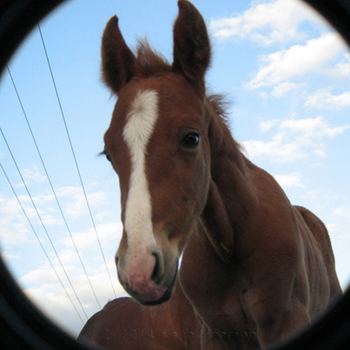Improve Your Balance - Teach Neck Reining (Part 2 of 2)
July 10, 2014
Written by: Keith Hosman
Written by: Keith Hosman
This is part two of a 2-part article series. Don't miss part one 'cause it sets you up for what you'll see here! You can read "Improve Your Balance - Teach Neck Reining, Part 1" when you follow this link.On horseback, pick out two points one or two hundred feet away from each other. Pick two trees or pitch out two feed buckets. Trot toward one. With a pronounced droop in the reins, hold them in one hand and place that hand just above and centered over the horse's neck, guiding and saying "trot in this direction." Your other hand should not be touching the reins at all at this point. Success here really depends on your leaving the horse alone more often than not. To steer, you will move your hand *slightly left or right, but not make big motions with the reins - and never, ever across the mane. (Yes, this is asking for him to make mistakes - but remember, that's part of the process.) If you find yourself absent-mindedly using the second hand too much, make an effort to keep that second hand on your thigh unless you really need to use it. One hand holds the reins and guides, the other hand stays on your thigh. Weaning yourself from the reins - and keeping that droop in them - teaches the horse to read your body language; it keeps you from over-guiding, from nitpicking and to find your balance.
* Remember: Your horse will "only ever be" as light as the lightest pressure you use. 
Feel for something as you ride: Your horse will most likely not travel with his front end directly behind his back end. (Watch your dog when he runs - he'll probably run with his hips way off to one side or the other. This is what your horse likely does, though hopefully, not in such a pronounced fashion.) This "line up' is one thing we're working to fix for the obvious fact that we haven't a prayer of traveling straight when the back wheels don't line up with the front. We want straight lines and round circles and we don't want to spend every moment course-correcting. Be aware and feel through your body. Ask yourself, which direction does this horse normally "leak" when I turn loose? If I dropped the reins, where would his feet go? Does he feel like he'd veer left or right? Note that the odds are pretty good you'll get this same answer ("He seems to carry his hips to my right/left; he seems to always veer inside/outside") regardless of where you are on your circle for the same reason that people wear their shoes unevenly as evidenced by the wear on the bottom of their shoes: It's the way we're individually built. Knowing this tells us that our fix is going to be the same now and five minutes from now and until the horse develops a more correct way of going.
You'll hold your reins low, guiding, and focus your eyes to a spot just to the side of the tree, there where you expect to initiate your turn. The very instant you feel your horse veer off course, (and he will hundreds of times), pick up your reins and ask him to trot a very small circle in the opposite direction. If he veers OUT of your circle, you turn 360 INTO the circle and vice-versa. In your turn, focus on keeping your horse's body bowed to mirror the shape of the turn and to keep him upright. (If he leans over one way or the other, ask for a slightly larger circle or do what you must with your reins to keep him evenly arched.) Complete a full turn, put your reins back down into "neutral," and head back to your tree. Don't let the small circle get sloppy or hurry through it. Make it as small as possible, but keep it correct, upright and fluid. Otherwise, you'll be teaching neck reining while practicing "turn sloppy." Do not pick up the reins as if to correct the horse; never see this as punishment. You're just adding in a tight loop to the pattern and it's all the same to you. Seeing it as a punishment will cause you to get harsh with those reins. Handling the reins in a harsh manner will only serve to cause him to fear a particular area in your pen. He'll think "Every time I get there, he yanks my mouth" and then the learning is over for the day.
The reason I coupled these two exercises (you concentrating on keeping a balanced seat with teaching the horse to neck rein) is simple: Each reinforces the other. If you ride with your gaze fixed on a target, (as outlined), your body will feel "cockeyed" when the horse veers off the proper line. You get a chance to teach your horse to stay between the reins; you also get a chance to adjust your balance and build up muscle memory. Through repetition, you learn to stay centered in the seat, your horse learns to go where you point. If you need help finding your balance or improving your seat: 1) Keep the following body parts balanced over each other: Head, shoulders, ribs, pelvis, legs/feet. Think of them as individual blocks that must be kept balanced over each other or, together, they'll collapse. 2) Don't picture yourself gripping the saddle so much as allowing gravity to keep you in rhythm with the horse and his movements. 3) If you are having trouble "getting in synch" with the horse's back, (as if working against his energy not with it), or need to adjust your seat side-to-side, trot with an arm raised high above you as if raised to the heavens. After a moment or two, drop your arm and raise the other in the same way. Doing this will lengthen your leg on the same side (as the raised arm) and help you naturally adjust your weight, side-to-side. You might also picture in your mind's eye that you are a car traveling down a rocky road, your bottom half absorbing the rises and falls, your top half staying even. A third thing to try: Ride off with both arms raised to shoulder level (making a giant T out of your body) and pulling your feet up and back toward your butt. Ride in this exaggerated fashion for a moment before returning to your normal position and you'll find a lowered sense of gravity, a greater sense of security. Tip: Teach almost anything to your horse with the "Clock Work Exercise." That's a chapter in the basic training book "What I'd Teach Your Horse" - and you can hear the whole section right now for FREE on audio when you click here.
4) If you feel yourself constantly making corrections because you feel as if you're dripping off the left or right side of the horse, post the trot for a moment, then sit two consecutive beats to swap your diagonals and trot a bit more. If you feel that you are placing more pressure in one stirrup (during that quick test) than the other, adjust accordingly: Move weight from one leg to the other to even things up. This may very well feel a bit unnatural to you if you've been riding "off" for awhile - but with practice, this more balanced seat will become habit. When you approach the tree and it's time to turn, turn and look over your shoulder at the other tree. Consciously amplify your movement and really stare where you want to go. Doing so will turn your body, pulling one leg against his side, throwing your weight onto one side of the saddle or into one stirrup more than the other. Give your horse a few steps to read this light signal. If he doesn't start turning, (and he may very well not at first) take a single rein and do one of two things: either bring it toward your opposite shoulder and apply the necessary pressure to cause his hips to do the turning - or bring your arm lower and in such a way that you pull his nose toward his hip. Either way, do your turning from the rear, from the back of the horse like you're a boat. (Not by guiding his front end.) If you feel that your horse is ignoring this request, his feet keep scooting without turning, then use one hand to bring his nose toward your opposite shoulder as outlined and use the other hand to pull directly back. That oftentimes will cause the legs on the same side to slow down, as if applying a brake. Don't use this second hand except when no amount of pressure from that first will cause a turn. If you seem to be causing a fight by turning in this way, then make your mind up to practice your "turns on the fore" (or hip disengagements) later and today just concentrate on holding your rein pressure until the tail of the horse is pointed away from the direction you'd like to head. Do a tight U-turn and head back to the other tree. This means that you will head to the tree and ask with a small movement from your hand for the turn (as well as by craning your head to look at the other tree, saying "turn" with your exaggerated body language). If he blows past this request, you will turn around the tree by turning the horse's hips (as opposed to steering his head). When he veers off your straight line (when you see that you will not be able to round the tree if he keeps going the way he's going) then you will turn the opposite direction into a very small circle before heading back to the tree. If, despite your best efforts, the horse starts to grow agitated or if you notice your horse actively avoiding the tree, (due to so many corrections made there perhaps) then try trotting to tree A and taking a break (one minute) there at the tree. Trot to the next tree and do the same. After a dozen or so times, he'll start heading to the tree because he finds that he gets a break there. This works to calm the horse and get him to more readily head in your chosen direction - but it'll do little to teach him to read your body language. He'll just head for the tree because of the association it has taken on as a place of rest. So... use it to throw your horse back into a proper and positive frame of mind, not so much to teach it to neck rein. When you can guide your horse successfully around the trees clockwise, reverse things. Then, when counter-clockwise is child's play, it's a simple thing to pick out several rocks or bushes and get better exponentially by practicing figure eights. Remember, if he veers off course, do tight turns the opposite direction to solidify in him the thought "stay between the guiding reins." If he ignores a request to turn (like to the left or right around a bush) swing his hips around to change course and say "You missed my cue to turn." Finally, see if you can't trot each letter of the alphabet. When you can get from A to Z, with a horse that stays between the reins and doesn't lean, you'll have really accomplished something. Wanna teach your horse to drop its head and stay relaxed? When you're finished with this article, click here to read about the "Classic Serpentine."
|
|

